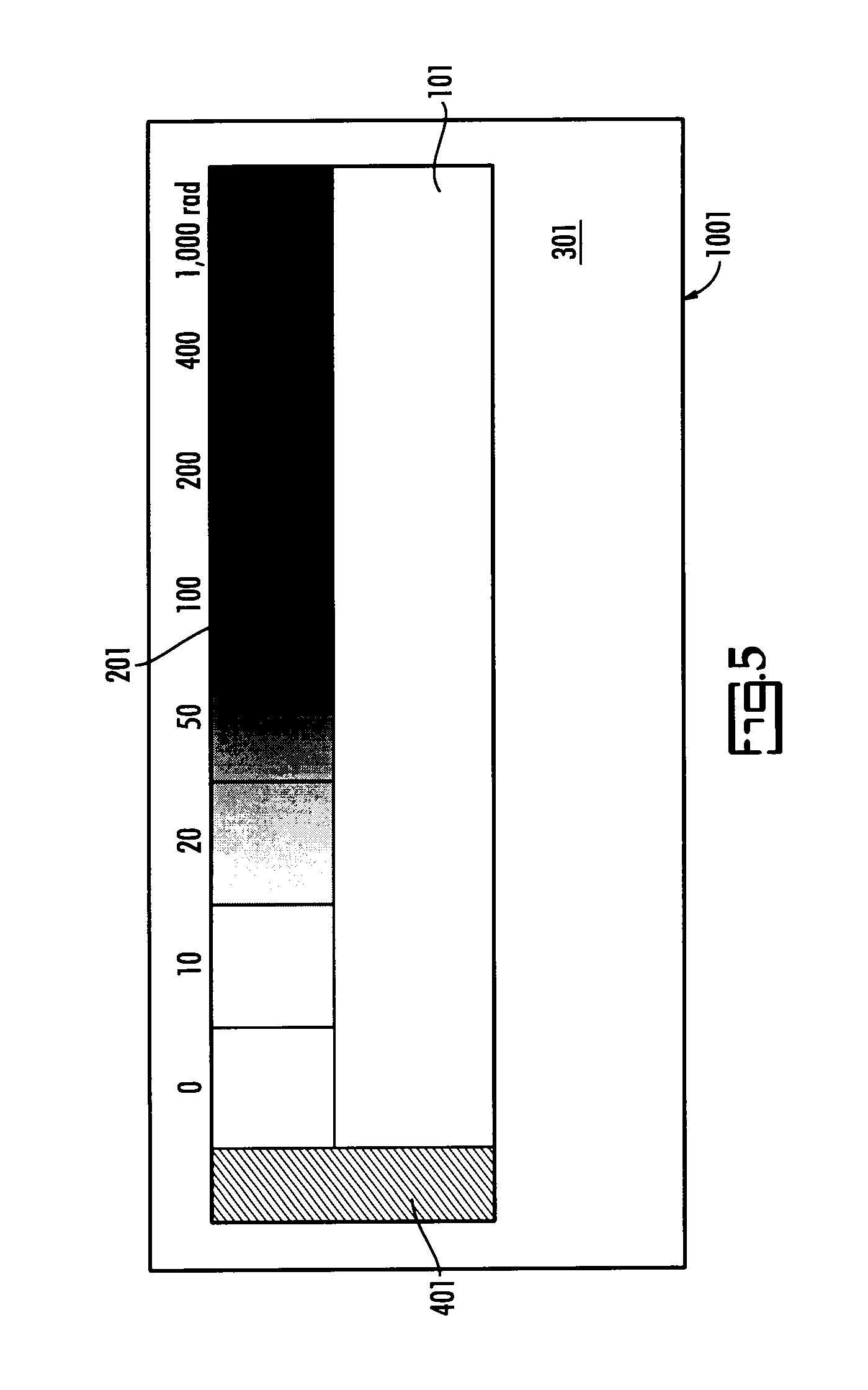Personal and area self-indicating radiation alert dosimeter
a dosimeter and self-indicating technology, applied in the field of personal and area self-indicating radiation alert dosimeters, can solve the problems of multi-step and expensive process, high cost of electronic equipment for monitoring radiation, and inability to provide information in time, etc., and achieve the effect of acceptable resistan
- Summary
- Abstract
- Description
- Claims
- Application Information
AI Technical Summary
Problems solved by technology
Method used
Image
Examples
example 1
Synthesis of diacetylene-344, 4,6-decadiyn-1,10-bis(n-butylurethane), R—C≡C—C≡C—R where R═(CH2)3OCONH(CH2)4H
[0203]In a 5,000 ml round bottom flask equipped with a stirrer and an addition funnel were added 400 gram (2.4 mole) of 4,6-decadiyn-1,10-diol and 1300 ml of anhydrous THF. The mixture was stirred to dissolve the diol. To the solution were added 1 gram of dibutyltin bis(2-ethyl hexanoate) and 10 ml of triethylamine as the catalysts. To the mixture was added 500 gram (5.05 mole) of n-butyl isocyanate over 45 minutes. Temperature of the reaction was maintained at ˜15° C. with ice-cold water. The mixture was stirred for one additional hour and then the temperature was raised to 50° C. The reaction was allowed to proceed for about half an hour and then 40 ml of methanol was added to destroy the excess unreacted isocyanate. The content was then cooled to −20° C. in a freezer over night. The diacetylene-344 was filtered cold and recrystallized first from ethylacetate followed by rec...
example 2
Preparation of Emulsion of Diacetylene-344 for the Pilot Plant Coating
Preparation of Solution of Polyvinylacetate (PVA):
[0205]In a 10 liter stainless steel beaker was added 2250 g of ethanol and 750 g of DI water and mixed. To the mixture was added 1,000 g of PVA (Aldrich Chemical, Mol. Wt. 500,000) under vigorous stirring for a few hours. The mixture was then stirred periodically. A highly viscous clear solution was obtained.
Preparation of the Emulsion:
[0206]In a five liter stainless beaker was added 1350 g of the above stock solution of PVA and 335 g of diacetylene-344 under stirring. The mixture was heated to ˜80° C. The solution was slowly poured into about 3 gallons of liquid nitrogen while stirring with a mechanical stirrer. The mechanical stirrer made the solidified emulsion in to a powder.
[0207]The solid emulsion was spread in to four aluminum (60×30×3 cm3) trays and allowed to warm up at room temperature overnight. The trays were covered with a plastic film with holes. The ...
example 3
[0208]The dosimeter-film was prepared by using a pilot coating facility (model number NRC3-300) of Yasui Seiki Co, Bloomington, Ind. The coating parameters, such as viscosity of the solutions, size of the coating bar, coating / film speed, coating thickness and drying rate / temperature were varied to obtain transparent uniform coating. The film was then coated on the back side under the identical conditions. The PVA / diacetylene-344 coats were then top coated with polyvinylacetate in ethanol:water (7:3) solutions using #60 cylinder, first on one side and then on the other. These and other parameters were varied until a uniformly coated dry film was obtained. The following were the optimized parameters used for making the transparent film of diacetylene-344 at Yasui Seiki Company.
[0209]
Coating ParametersReference SampleDosimeter 344Web / film12″ wide, 100 micron thick clear subbed CronarR film.Emulsion1:1 Mixture of PVA:diacetylene-344 in 3:1 ethanol:water.Viscosity of t...
PUM
 Login to View More
Login to View More Abstract
Description
Claims
Application Information
 Login to View More
Login to View More - R&D
- Intellectual Property
- Life Sciences
- Materials
- Tech Scout
- Unparalleled Data Quality
- Higher Quality Content
- 60% Fewer Hallucinations
Browse by: Latest US Patents, China's latest patents, Technical Efficacy Thesaurus, Application Domain, Technology Topic, Popular Technical Reports.
© 2025 PatSnap. All rights reserved.Legal|Privacy policy|Modern Slavery Act Transparency Statement|Sitemap|About US| Contact US: help@patsnap.com



